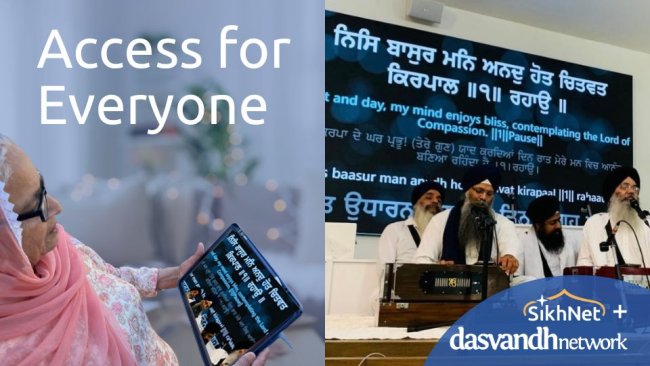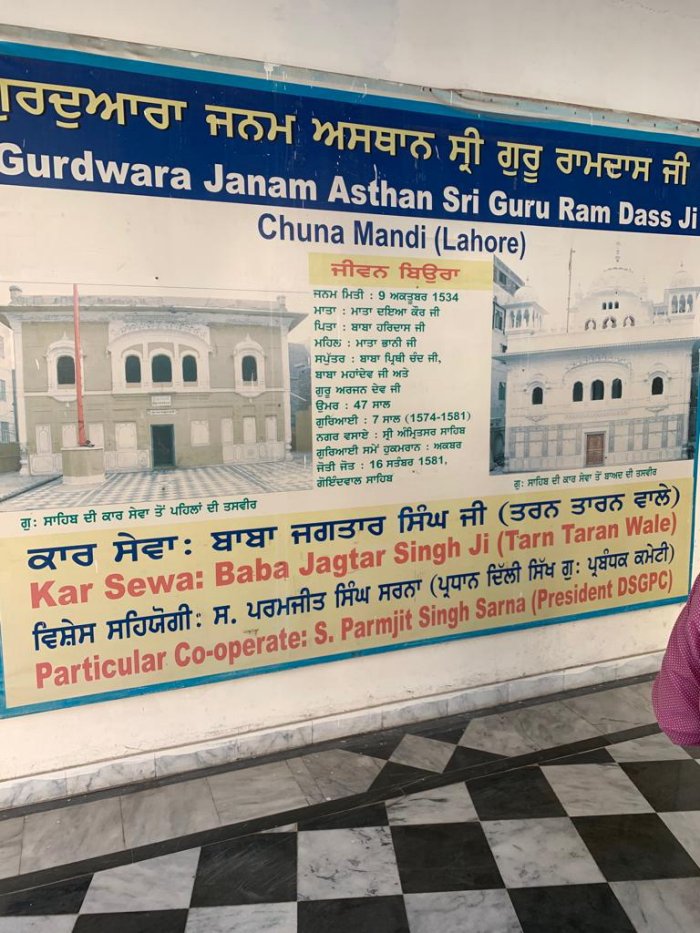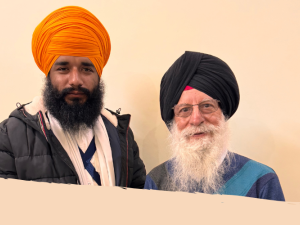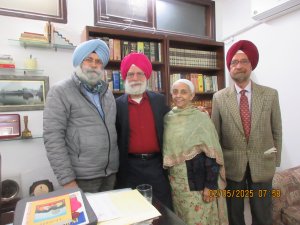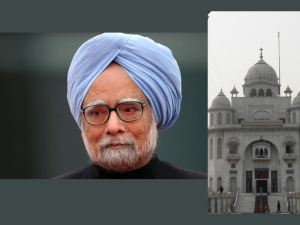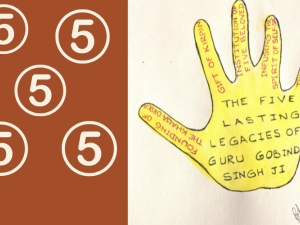"ਚਲੀ ਪੀੜੀ ਸੋਢੀਆ ਰੂਪੁ ਦਿਖਾਵਣਿ ਵਾਰੋ ਵਾਰੀ ।"
“Chalee peeRee soddeeaa roop dhikhaavan vaaro vaaree.” (Bhai Gurdas Vaar 48.1)
Translation: Now the Sodhi lineage has started and they all will show their selves turn by turn.
This above quote by Bhai Gurdas sums up the great legacy that was started with the birth of Guru Ram Das Ji. Altogether a total of seven descendants from this lineage donned the mantle of Guruship. He was born on October 9 (September 24 in most printed books) 1534, according to the signboard at the Guru Ji’s birth place at Chuna Mandi, Lahore. His parents were Bhai Hari Das Sodhi and Mata Daya Kaur (also known as Anup Devi). He was named Ram Das, but family used to call him Jetha, meaning eldest child. He had one younger brother and a sister. Bhai Har Das had met Guru Nanak Dev Ji in Lahore, when Guru Ji came there and visited Duni Chand.
This historical place of birth is located in the old part of the city. The street leading to this shrine is from Delhi Darwaza. The street is quite narrow, with heavy pedestrian traffic in the midst of wholesale clothes market. No vehicular traffic is allowed, so we walked from Delhi Darwaza to get there. One has to be extra cautious walking up the slope with overflowing sewer water flowing down. The shrine building is at a slightly elevated level with steps leading to the entry door. The present building is being renovated over the earlier one; which was constructed during Maharaja Ranjit Singh’s time. The building is made from white marble. The main wooden door has elaborate and fine quality workmanship. The motifs and designs are elegant and typical of the style in that part of the country. Inside the Gurudwara, few tile bricks from the earlier times have been preserved as a historical evidence of construction style used in the past. There is also a small recessed marble tub at the spot where Guru Ram Das Ji was given first bath after birth. After the partition of the country in 1947, this shrine became nonoperational. This has been reopened in last few years and now daily parkash of Guru Granth Sahib is taking place.
There is not much information about the childhood of Guru Ram Das Ji, except that his parents were poor and he was orphaned at young age of seven. Both his parents had passed away in quick succession. So, the society treated him with disdain, as he was believed to be bad omen for the demise of his parents. Many parents discouraged their children from playing with him. Even the uncles of Jetha did not allow their children to play with him. He was even ostracized from visiting with them. When his maternal grandmother came to Lahore and saw the grim situation, she decided to take the 3 children with her to Baserke. To make a living, his grandmother would make boiled salted black chick peas, and Jetha would sell them on the streets in Baserke. So, at a tender age of seven, Jetha became the bread winner for the family and his education took a back seat. In 1546 Sri Amar Das colonized Goindwal at the direction of Guru Angad Dev Ji. When Sri Amar Das came to Baserke, to take his family with him to Goindwal, he took Jetha along with him. So, besides serving Sri Amar Das, he continued his business of selling black chick peas.
Shri Amar Das was entrusted the Guruship in 1552 AD by Guru Angad Dev Ji and was commanded to set up his preaching center in Goindwal. Guru Amar Das Ji considered Bhai Jetha Ji as most eligible groom and married his daughter Bibi Bhani to him in December 1552. After the wedding when the groom made the first visit to his in-laws house, Guru Amar Das Ji asked him to choose a gift for himself as was the tradition in Guru Ji’s family. Sri Ram Das Ji’s reply was:
"ਹਮ ਕੀਰੇ ਕਿਰਮ ਸਤਿਗੁਰ ਸਰਣਾਈ ਕਰਿ ਦਇਆ ਨਾਮੁ ਪਰਗਾਸਿ ॥੧॥"
“Hum keerae kiram satigur saranaiee kar daya naam paragaas.1.” (SGGS, Pg. No. 10)
Translation: I am a mere insect, a worm. O True Guru, I seek Your Sanctuary. Please be merciful, and bless me with the Light of the Naam, the Name of the Lord.
Here we can see a personality steeped in humility, simply begging for Naam, which is elixir of life. In fact, there is no life without Naam was deeply ingrained in him. But in order to get true picture we can turn to those who were the eye witnesses during that period and their words are enshrined in Guru Granth Sahib. Bhai Satta and Balwand said:
"ਧੰਨੁ ਧੰਨੁ ਰਾਮਦਾਸ ਗੁਰੁ ਜਿਨਿ ਸਿਰਿਆ ਤਿਨੈ ਸਵਾਰਿਆ ॥"
“Dha(n)n dha(n)n raamadhaas gur jin siriaa tinai savaariaa.” (SGGS, Pg. No. 968)
Translation: Blessed, blessed is Guru Raam Daas; He, who created you, has also exalted you.
Guru Amar Das Ji was so impressed with his humility and service to others that besides giving hand of his daughter to him in marriage, also appointed him as his successor Guru. Guru Ram Das Ji paints the picture of his elevation to that position in these words:
"ਜੋ ਹਮਰੀ ਬਿਧਿ ਹੋਤੀ ਮੇਰੇ ਸਤਿਗੁਰਾ ਸਾ ਬਿਧਿ ਤੁਮ ਹਰਿ ਜਾਣਹੁ ਆਪੇ ॥
ਹਮ ਰੁਲਤੇ ਫਿਰਤੇ ਕੋਈ ਬਾਤ ਨ ਪੂਛਤਾ ਗੁਰ ਸਤਿਗੁਰ ਸੰਗਿ ਕੀਰੇ ਹਮ ਥਾਪੇ ॥"
“Jeo hamaree bidh hotee mere satiguraa saa bidh tum har jaanahu aape. Hum rulate firate koiee baat na poochhataa gur satigur sang keere ham thaape.” (SGGS, Pg. No. 167)
Translation: My condition, O my True Guru - that condition, O Lord, is known only to you. I was rolling around in the dirt, and no one cared for me at all. In the Company of the Guru, the True Guru, I, the worm, have been raised up and exalted.
Guru Ram Das Ji remained the Guru of Sikhs for only a short stint of seven years, breathing his last in year 1581. During his Guruship, Guru Sahib focused especially on organizing the structure of the Sikh society. He created and planned the township of Ramdaspur, which today is known Amritsar-the holiest shrine of the Sikhs. This city continues to flourish becoming the spiritual and political center of the Sikh faith. His other major contribution is the introduction of a new and distinct Sikh code of marriage, with the composition of hymn known as Laavan. His composition instructing Sikhs how to practice their religion is a testimony of his foresight. In addition he organized a system of Masands, as hubs to spread the message to the masses. They also collected funds and sent them over to Guru Ji to use for religious purposes. One line from Guru Granth Sahib by Guru Ram Das Ji salutes the parents who gave birth to the Guru in these words:
"ਧਨੁ ਧੰਨੁ ਪਿਤਾ ਧਨੁ ਧੰਨੁ ਕੁਲੁ ਧਨੁ ਧਨੁ ਸੁ ਜਨਨੀ ਜਿਨਿ ਗੁਰੂ ਜਣਿਆ ਮਾਇ ॥"
“Dhan dha(n)n pitaa dhan dha(n)n kul dhan dhanu su jananee jin guroo janiaa mai.” (SGGS, Pg. No. 310)
Translation: Blessed, blessed is the father; blessed, blessed is the family; blessed, blessed is the mother, who gave birth to the Guru.
Our salute to Guru Ji will be to visit his place of birth and be blessed by that visit.
Related articles:
Quest for Khuley Darshan - Part 1: Kartarpur
Quest for Khuley Darshan - Part 2: Janam Asthaan
Quest for Khuley Darshan - Part 3: Sacha Sauda
Quest for Khuley Darshan - Part 4: Birthplace of Langar
Quest for Khuley Darshan - Part 5: Bed of Stones
Quest for Khuley Darshan - Part 6: Birth of Martyrdom
Quest for Khuley Darshan - Part 7: Mother's Birthplace
Quest for Khuley Darshan - Part 8: Panja Sahib
Quest for Khuley Darshan - Part 9: Baba's Tree
Quest for Khuley Darshan - Part 10: Nanaki's Birthplace
Quest for Khuley Darshan - Part 11: 4th Guru Birthplace
Quest for Khuley Darshan - Part 12: HotBed of History
Quest for Khuley Darshan - Part 13: Conclusion
Editor's note: This article was originally published on Aug. 8th 2019
